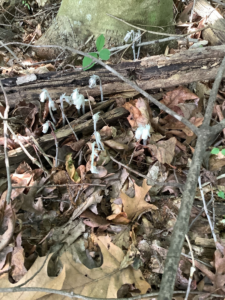The overlook behind you is perhaps the most scenic section of the CERA trail.
To the north, the land slopes almost twenty feet down to the stream of Herbert Run. Beyond the creek there is a large open area with no trees at all – how this happened is not complete clear. Turning toward the right there is a large White Oak growing at a tilt up the hillside. Oaks play an important role in supporting birds because they host close to 1,000 caterpillar species, which are a nutrient-rich food for baby birds.
In contrast, the soil on this upland where you are standing is well drained and fairly dry. But the fact that virtually nothing grows under the rainshadow of this large tree with smooth, silver-gray bark is not due entirely to the dry soil. This tree, an American beech, has an extensive root system that is particularly competitive for the limited nutrients found in the upper portion of acid soils such as these found in this area.
Keep an eye out for Ghost pipes if you happen to be walking this part of the trail in the month of June. These are wildflowers that are completely white and don’t photosynthesize like other flowering plants. All you see of the plant is a long stem popping out of the ground holding a single flower.

